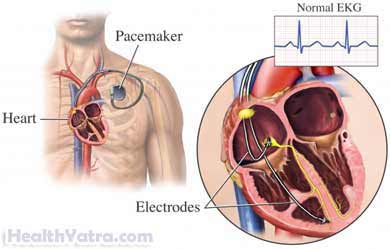تعريف
A doctor guides robotic arms to do surgery on the heart. The surgery is done through several tiny keyhole incisions.
أسباب هذا الإجراء
Robot-assisted cardiac procedures are done to treat a variety of conditions:
- Robot-assisted mitral valve repair may be used to treat:
- Stenosis (narrowing) of the mitral valve
- Regurgitation (leakage) of the mitral valve
- Robot-assisted coronary artery bypass grafting (CABG) may be used to treat:
- Blockages in the heart’s arteries
- Severe chest pain ( angina) that has not improved with medicines
- Robot-assisted عيب الحاجز الأذيني repair may be used to treat a hole between the upper chambers of the heart that does not close properly during fetal development.
- Robot-assisted biventricular pacemaker lead placement may be used to treat heart failure due to atrial fibrillation (irregular heart rhythm in the upper chambers of the heart).

Benefits of robot-assisted cardiac procedures may include:
- Increased range of motion with the robotic arms
- Ability to filter out human hand tremor and translate the doctor’s larger hand movements into smaller ones
- Reduced trauma to the body
- Shorter hospital stay
- Faster recovery
المضاعفات المحتملة
Complications are rare, but no procedure is completely free of risk. If you are planning to have a robot-assisted cardiac procedure, your doctor will review a list of possible complications, which may include:
- Damage to neighboring organs or structures in the chest
- العدوى
- نزيف
- Blood clots
- المشاكل المتعلقة بالتخدير
- موت
بعض العوامل التي قد تزيد من خطر المضاعفات تشمل:
- Prior heart attack or heart surgery
- سن متقدم
- مرض السكري
- السمنة
- التدخين
- الإفراط في تناول الكحول
- Uncontrolled thyroid disease
تأكد من مناقشة هذه المخاطر مع طبيبك قبل الجراحة.
ما يمكن توقعه
قبل الإجراء
Depending on the reason for your surgery, your doctor may do the following:
- اختبار بدني
- اختبارات الدم والبول
- Electrocardiogram (ECG, EKG) —a test that records the electrical currents passing through the heart muscle
- Coronary angiogram —a test to determine the extent and location of blockages of blood vessels supplying the heart muscle
- الأشعة السينية للصدر — اختبار يستخدم الإشعاع لالتقاط صورة للهياكل الموجودة داخل الصدر
- Ultrasound —a test that uses sound waves to visualize structures inside the chest
- CT scan —a type of x-ray that uses a computer to create images of structures inside the chest
- MRI scan —a test that uses magnetic waves to make pictures of structures inside the chest
قبل الإجراء:
- Talk to your doctor about your medicines. You may be asked to stop taking some medicines up to one week before the procedure, such as:
- الأدوية المضادة للالتهابات (مثل الأسبرين)
- Blood thinners, like clopidogrel (Plavix) or warfarin (Coumadin)
- Take antibiotics if instructed.
- Follow a special diet if instructed.
- Shower the night before using antibacterial soap if instructed.
- Arrange for someone to drive you home from the hospital. Also, have someone to help you at home.
- تناول وجبة خفيفة في الليلة السابقة. لا تأكل أو تشرب أي شيء بعد منتصف الليل.
التخدير
There are two options for anesthesia:
- General anesthesia —blocks pain and keeps you asleep through the surgery
- Local anesthesia with sedation—just the area that is being operated on is numbed, given as an injection
وصف الإجراء
The doctor will cut several keyhole openings in the spaces between the ribs. Next, the doctor will pass a small camera through one of the incisions. This small camera is called an endoscope. It will light, magnify, and project an image of the organs onto a monitor. The endoscope will be attached to one of the robotic arms. The other arms will hold instruments for grasping, cutting, dissecting, and suturing. These may include:
- Forceps
- Scissors
- Dissectors
- Scalpels
While sitting at a console near the operating table, the doctor will look through lenses. He will see magnified 3D images of the inside of the chest. Another doctor will stay by the operating table and adjust the camera and instruments. The console will have joystick hand controls and foot pedals. Using these, the doctor will guide the robotic arms and instruments. After the instruments are removed, incisions will be closed with sutures or staples.
مباشرة بعد الإجراء
After the procedure, you will be:
- Moved to the intensive care unit (ICU)
- Closely monitored
- Encouraged to sit up and move around soon after surgery
كم من الوقت سيستغرق ؟
Usually 1-4 hours (depending on the procedure)
كم هو مؤلم ؟
You will have pain and soreness during recovery. Ask your doctor about pain medicine.
متوسط الإقامة في المستشفى
This procedure is done in a hospital setting. The usual length of stay is dependent on the procedure you had done. Your doctor may need to keep you longer if you have any problems.
رعاية ما بعد العملية
عند عودتك إلى المنزل، قم بما يلي للمساعدة في ضمان التعافي بسلاسة:
- Follow your doctor’s guidelines on taking medicine. You may need to take antibiotics.
- Do deep breathing and coughing exercises.
- اتبع حمية غذائية خاصة.
- Wash the incisions with mild soap and water.
- اسأل طبيبك حول, عندما هي آمنة للاستحمام, السباحة, أو نقع في الماء.
- Limit certain activities (eg, driving, strenuous activity).
- Enroll in a cardiac rehabilitation program.
- تأكد من اتباع تعليمات طبيبك.
استدعاء الطبيب
بعد مغادرة المستشفى، اتصل بطبيبك في حالة حدوث أي مما يلي:
- علامات الإصابة, بما في ذلك حمى وقشعريرة
- Redness, swelling, increasing pain, excessive bleeding, or discharge from an incision site
- السعال، ضيق التنفس، أو ألم في الصدر
- Difficulty urinating, such as pain, burning, urgency, frequency, or bleeding
- الغثيان أو القيء الشديد
- Rapid weight gain
- ألم و/أو تورم في قدميك، أو ساقيك، أو ساقيك
- Headache, feeling faint or dizzy
- Other worrisome symptoms
في حالة الطوارئ ، اتصل على المساعدة الطبية على الفور.
